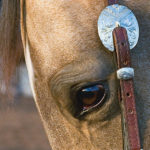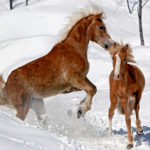 Credit: Kimberly S. Brown Photo Corralling clutter is as much about changing our way of thinking as it is about adding shelves, racks, hooks and other organizers to your barn.
Credit: Kimberly S. Brown Photo Corralling clutter is as much about changing our way of thinking as it is about adding shelves, racks, hooks and other organizers to your barn.Editor’s Note: With the number of horses and humans around a boarding stable, there always seems to be “things” that either are not in their “place,” or don’t have a “place” where they belong. We collected some tips from articles on StableManagement.com that might give you some ideas and ways to de-clutter your barn.
Bridles, halters, lead ropes, crops, helmets, wraps, blankets, and bottles of fly spray and ointment bulge out of every nook and cranny of our tack room and barn aisle. Clutter weighs on our minds and creates dangerous situations for horses and riders.
Corralling clutter is as much about changing our way of thinking as it is about adding shelves, racks, hooks and other organizers to your barn.
Here are five clutter busters for you from Katie Navarra.
1. Consider selling How many pairs of leg wraps, bridles, saddle pads, brushes, etc. do you truly need? If you’re not running a lesson program that requires you to always have that extra piece of equipment, think about selling or donating equipment you haven’t used in the last year. Encourage boarders to do the same. If you sell it, the extra cash can come in handy for bills, unexpected repairs, emergency vet calls, or purchasing that “other” piece of equipment you want. Or you can donate the items to an equine fundraiser (check with your local Pony Club, mounted police, therapeutic riding group, or 4-H extension leader).
2. Purge broken items It’s tempting to save that sheet with a tear or that halter that needs a new snap. If possible, fix repairable items immediately. You also can place a labeled box or bag in a prominent place in the tack room for “repairable” items. That keeps them out of the “usable” group (thus saves you time remembering “Oh yeah, that one has a broken strap” every time you choose equipment) and keeps them all in the same spot, ready to take to be repaired. Set a reminder on your calendar at least each quarter and allocate time to take the equipment to be repaired. If a torn blanket or broken halter is still around months (or years) later, it’s time to part ways. If it is repairable and you just don’t want it, donate it to one of the groups listed above.
3. Set limits Decide how long an unused piece of equipment can linger. It may be one year or five years, but if the item hasn’t been used within the allotted time, it’s time to sell or donate it. It helps to have a semi-annual inventory of your equipment (going into winter and before spring) so that you know what you own. This list is also good for insurance purposes, and the timing allows you to get blankets out and inspected for winter or cleaned, repaired and put away for summer.
4. This for that Shopping for new equipment is fun! But before placing the new purchase in the tack room, feed room or trailer, remove the item being replaced. If it is still serviceable, sell or donate it.
5. Get started Cutting clutter is daunting. Avoid thinking about how much work you have to do and start in one area. Chances are clutter is slowly taking over the barn office, the grooming stall, the tack room and the trailer. Pick one area and start there. A feeling of accomplishment will motivate you to move on to other areas. Setting a reminder in your calendar and allocating time for each area will help you succeed.
And here are some more ways to help de-clutter your barn from Katie Navarra.
Clean-up for a good cause: There’s likely at least one, if not more, non-profit horse organizations in your area. Clear out unused blankets, tack and other items that are not used at your barn and donate them to a facility that can use the items. Let your boarders know what you are doing so they can contribute. Don’t forget to save receipts as donations to certain charities are tax deductible.
Corral cans: Do boarders and lesson riders arrive with bottles of water or sports drinks to stay hydrated during their visit to the barn? Do the cans and bottles get forgotten when they leave, meaning you have to pick them up off of fence posts, rails, barn aisles and hay bales? Designate an area for general recyclables and encourage your boarders to help the barn “get green.” If your state pays refunds, set up a separate container for refund bottles. Use the refund to purchase needed supplies or treat clients to pizza or snacks.
Abundant hooks and hangers: Do halters, extra reins and other equipment end up on the floor because boarders try to put too much onto one hook or hanger? Invest in additional hangers and hooks to avoid clutter on the floor and over-full tack rooms.
Not your clutter?: This is the most offensive type of clutter, because it’s not even your clutter!How many times has a boarder moved out or a lesson rider moved on to another barn and left behind equipment? If you can’t get it back to its original owner, donate it, sell it or toss it. Don’t just leave it piled up collecting dust and mold.
Have a vision: Before cleaning out a space envision what you’d like to do with it once the clutter disappears. A definite purpose for a newly cleared area will limit clutter from creeping back in.
And here’s an extra time-saving tip for you!
Top it off: Fill the gas tanks in utility vehicles, tractors and even vehicles at the end of the day. That way if you’re running late in the morning, it’s one less thing to worry about. You’ll be especially thankful if you’re racing Mother Nature to do chores, plow snow and salt walkways.
And here are some other articles from StableManagement.com that you might find useful.






